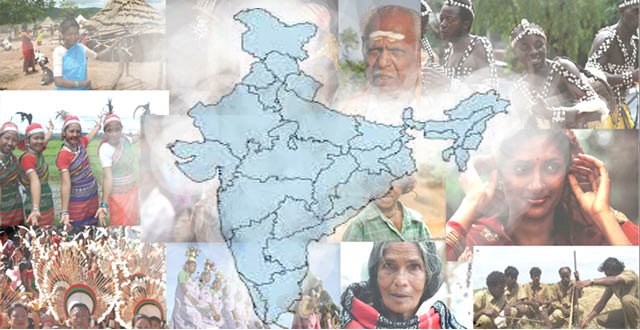The Indian tribal in Jharkhand
Jharkhand is a significant state from the perspective of tribal people in India. There are approximately 30 types of Tribes in Jharkhand state.
The total Tribal population constitutes 27
percent of the Jharkhand population of 2.70 crores. The PTG population is just
2.23 lakh as per the 2011 Census.
As per a survey conducted by NGOs, in the 5 Birhore Tandas in Giridih the literacy rate among PTG is just 16.87 percent against the state average of 54 percent; gross cultivable land among PTG is 0.21 hectare per family against state average of 0.82 hectares. The average monthly income of PTG is just between Rs. 500 and Rs. 1,000.
The Majority of the primitive tribal
population groups in Jharkhand is in perpetual poverty and stands much below
the poverty line, suffering from alarming malnutrition and high illiteracy.
The state government along with the district administration is making the best
possible effort in creating sustainable development programs among them
After having been specially identified as
the Primitive Tribal Groups by the Government of India on the basis of certain
administrative criteria, these sorted out tribal communities mitigating their
hazards and anxieties, consternations, and tribulations in their life situation.
Following are some tribes of Jharkhand:-
ASUR
Asur is an important tribe in the state ofJharkhand in the eastern part of the subcontinent of India. Asur in Jharkhand
is one of the thirty major tribes of people who have made the state of
Jharkhand their home. The people who belong to this tribe form quite a big part
of the total population of the state of Jharkhand.
CHICK BARAIK
The Chick Baraik of Jharkhand is found in
Ranchi, Lohardaga, and Gumla districts. The Chick Baraik in Jharkhand belongs to
the Proto-Australoid and speaks Mundari, Hindi, and Sadani languages. The Chick
Baraik tribe presents a picture of communal harmony. In Jharkhand, the Chick
Baraiks do not dwell in a separate village but live with the other tribes and
castes within the same village. In fact, it can be said that they celebrate
fraternity and brotherhood.
CHERO
The Chero is one of the scheduled tribesof Jharkhand. In Jharkhand, Chero dwells in the districts of Ranchi, SathalPargana, Latehar, and Palamu. Palamu seems to have a larger concentration of the Chero tribe in Jharkhand. Besides, the Chero at Jharkhand is also found in Bhojpur, Gaya, Champaran, Munger, Daltonganj, Patan, Lesliganj, Bhawanathpur, Rohtas, etc. It is noteworthy in this context that the Chero, also known as Cherwas or Cherus, was a martial group that annexed many new territories through war. They are said to be descendants of the Kshatriya lineage known as Chandravanshi. The Chero of Jharkhand follows a patriarchal form of the society where women are exempted from all the rights to inheritance and succession.
KARMALI
Karmali in Jharkhand is found in Ranchi,
Hazaribagh, SanthalParganas, Singhbhum, and Bokaro districts. Karmali at
Jharkhand is one of the scheduled tribes of Jharkhand who are also known as the
artisan tribes of Jharkhand. Karmali of Jharkhand is known for a nuclear
family system where the father is the head of the family. The nuclear family of Karmali is composed of a man and his wife and children. The children live
with their parents till they are single: after their marriage, the children set
up a family of their own. Therefore, we can say that the Karmali tribe
celebrates a nuclear family: the concept of a joint family is completely absent
in the Karmali society.
MUNDA
The abode of the members of the extremely cherished Munda tribe is not confined to the borders of the state of Jharkhand. The Munda people have also penetrated into other beleaguering states of Orissa, Chattisgarh, Bihar, and West Bengal. As a matter of fact, a handful of the Mundatribals have also been noted to have established their permanent domicile in Bangladesh as well. The sphere where the Munda in Jharkhand bears a remarkable similitude with its contemporary tribes is mainly concerned with a conspicuous dialect and a unique lifestyle. This could be vividly illustrated by the fact that the lingo restricted to them is known as 'Mundari'. The legend that exists behind this extremely coveted and revered language elucidates that Mundari actually belonged to the Austro-Asiatic family of languages. According to the last census, the estimated number of members of the Munda across Jharkhand totals up to twenty lacs or two million.
ORAON
The individuals of the Oraon tribe not only
inhabit the domain of Jharkhand but a handful have also successfully fanned out
into many economically and technologically sound cities like Delhi, Kolkata, and
Mumbai as educated and well-employed individuals. Previously, the members of
the Oraon clan extracted their livelihood from chopping trees, accumulating
timber, and doing other forest-related activities. They also depended on the woods to
procure them with all the essential ingredients required to perform their
rituals. But as we entered the threshold of the 21st century, the tribal people
of the Oraon of Jharkhand have taken up agriculture as their primary means of
earning their livelihood.








Comments
Post a Comment